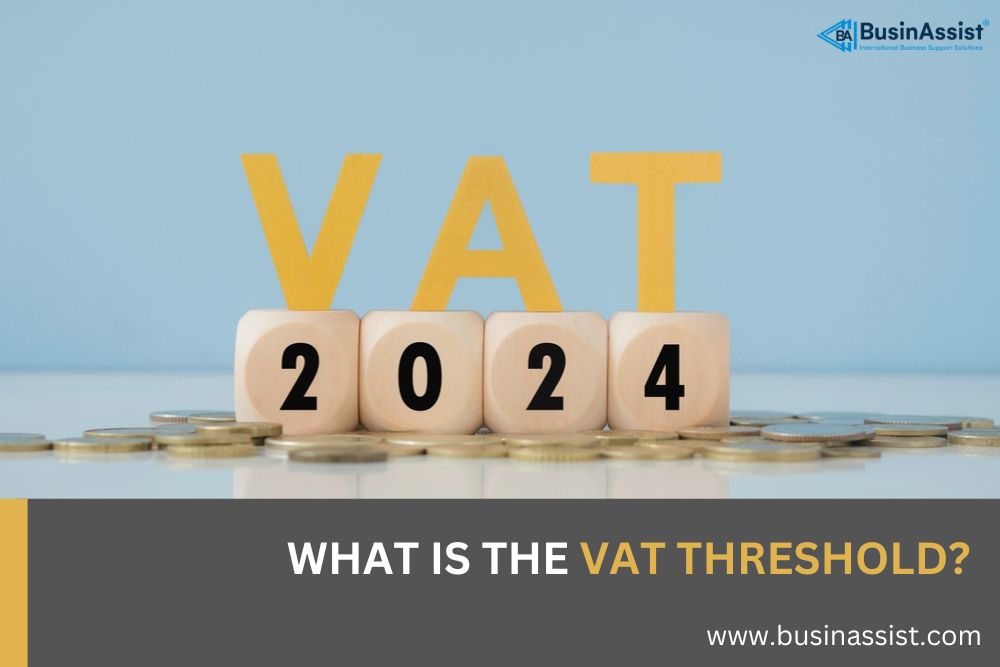Last Updated on December 24, 2025 by Joy Kyalo
What is the VAT threshold? Among taxes administered in the UK, Value Added Tax (VAT) is one of the taxes affecting business owners or taxable individuals who have registered for VAT.
VAT is a consumption tax that is added to products and services. So, when your business purchases products or necessary resources from a supplier, you’ll need to pay VAT on these items. Businesses collect sales tax (VAT) from their customers and pay it back to the government. The standard VAT rate in the UK is 20%.
Businesses are legally required to register for VAT if their taxable turnover for the last 12 months is more than the VAT threshold.
What is the VAT threshold? This guide will take you through what the VAT threshold is and when your business should register for VAT and returns, so you can stay compliant and run your business with ease.
What is the VAT threshold?
The VAT threshold, also known as the VAT registration threshold, is the amount of money you can earn before you need to register for VAT.
Currently, the VAT registration threshold is £90,000. This changed on 1st April 2024 and represents a £5,000 rise over the previous threshold of £85,000.
If your business’ VAT taxable turnover for the last 12 months is more than £90,000 (the VAT threshold), you are legally required to register for VAT.
Additionally, you will need a VAT number if you expect your turnover to go over £90,000 in the next 30 days.
You will also need a VAT number if you only sell goods or services that are exempt from VAT but you buy goods for more than £90,000 from EU VAT-registered suppliers to use in your business.
You can also apply for a VAT number even if your turnover is less than £90,000 through voluntary registration.
Another common reason why a business may be forced to register for VAT is if it takes over an existing business that is VAT-registered.
What are the VAT rates in the UK?
The kind of products or services you offer determines what constitutes the VAT rate you need to charge. the VAT rates are as follows:
Standard rate: 20%. This rate applies to most goods and services.
Reduced rate: 5%. It applies to specific items such as children’s car seats and home energy.
Zero rate: 0%. Certain goods and services fall under this category, including most food and children’s clothes.
What is the difference between zero-rated and exempt items?
Zero-rated items are subject to a 0% VAT rate. Businesses still need to account for VAT on zero-rated sales, but the actual tax amount charged to customers is zero.
Examples of zero-rated items include most food, children’s clothes, and books.
Exempt items are not subject to VAT at all. Businesses do not charge VAT on exempt sales, and they also cannot reclaim input VAT related to these items.
Examples of exempt items include medical services, educational services, and financial transactions.
How do I avoid the VAT threshold?
If your taxable turnover exceeds £90,000, you’re required to register for VAT. However, there are ways to avoid reaching this threshold:
Voluntary registration: Even if your turnover is below £90,000, you can choose to register voluntarily. This might be beneficial if you want to reclaim input VAT on business expenses.
Monitor your turnover: Keep a close eye on your taxable turnover. If it approaches the threshold, consider adjusting your business practices to stay below it.
Timing: The threshold is based on a rolling measurement. For example, if you look at your turnover for the year up to June 30 and it’s below £90,000, you’re fine.
How to obtain a VAT number in the UK?
We offer VAT registration services where we will do an online application for you after you provide all the necessary documents for only £35.99.
We will handle all communications with HMRC on your behalf and update you on the status of your application.
We also do monthly and quarterly VAT returns to ensure VAT compliance. This service can save you time and effort in managing your VAT obligations.
Before you register for VAT, make sure you have;
- Your tax reference number (UTR)
- Your business contact details
- Your business’s annual turnover
- National insurance number
- Information on the nature of your business
- Bank account details
- Records of companies you’ve previously owned (over the previous two years)
Once the application is approved, you’ll receive a 9-digit VAT number to include in all invoices. You will also get information about when to submit your first VAT return and payment and a confirmation of your effective date of registration.
What is the most appropriate VAT scheme for your business?
Flat-Rate Schemes – These schemes allow you to determine VAT payments based on your total profits, rather than accounting for VAT on individual purchases. Depending on your gross sales, this can result in lessened VAT liabilities.
Cash Accounting Schemes – If your business relies on invoices for customer payments, cash accounting schemes can help maintain your cash flow. These schemes mean you’ll only pass along VAT once a customer has paid for their product or service.
Standard VAT Accounting: If you reclaim VAT regularly, this method allows you to account for VAT on your sales and purchases. You submit quarterly VAT returns and pay the difference between output tax (what you charge customers) and input tax (what you pay on expenses).
Annual VAT Accounting: With this scheme, you make payments either quarterly or in nine monthly installments. It simplifies your VAT reporting by submitting only one annual return.
VAT Margin Schemes: If you sell second-hand goods or operate in the retail sector, these schemes allow you to pay VAT on the value you add to goods, rather than the full selling price 2.
VAT Retail Schemes: Retail businesses can choose from three options to simplify VAT calculations.
How can I calculate my taxable turnover accurately?
To calculate your taxable turnover accurately, follow these steps:
Define turnover: Determine what constitutes your business turnover. It includes the total value of all goods and services you sell, excluding VAT.
Add up sales: Sum up the sales invoices you’ve issued during a specific period (e.g., a month or a year). Include both standard-rated (20% VAT) and zero-rated sales.
Exclude exempt sales: Exclude any exempt sales (e.g., financial services, insurance, or certain types of education) from your total turnover.
Include other income: Add any other income related to your business, such as rental income or interest received.
Subtract returns and discounts: Deduct any returns, discounts, or allowances given to customers.
Exclude non-business income: Exclude non-business income, like personal investments or gifts.
Conclusion:
In conclusion, when your annual sales turnover reaches or exceeds £90,000, it becomes a legal requirement to register for VAT. Businesses need to keep track of their taxable turnover to ensure compliance with VAT regulations.
Voluntary VAT registration can help your business in the long run but this decision is not to be taken lightly. You should ensure voluntary VAT registration will allow you to achieve your business goals.
BusinAssist provides VAT registration services to all types of businesses. The process of UK VAT registration differs based on the nature of your business, your business activities, where it is located, where the company directors or business owners are located, to where or from the goods are being shipped, where they are being stored, how they are being delivered to your customers. BusinAssist can help you register for VAT whether you are a sole trader, non-UK company or a UK limited company.
To streamline your VAT process, you can contact us at info@businassist.com.
Read Also:
- What is an EORI Number? – A Guide
- What is a VAT registration number? – A complete guide
- Is it worth selling on TikTok for your small business?
- What Are the Disadvantages of a Dormant Company?
- Understanding the Importance of a Tax Identification Number in the UK
- Everything You Need to Know About Companies House Default Address
- Understanding the Timeline: How Long Does It Take to Get a Tax Refund After Self-Assessment?
- How to Find a Company’s VAT Registration Number in the UK: A Step-by-Step Guide

The BusinAssist Editorial Team has 15+ years of experience writing about small business and company formation in the UK, Canada, and the USA. We simplify complex processes and provide practical insights to help entrepreneurs succeed. Business Assist with BusinAssist – your partner for business success.
